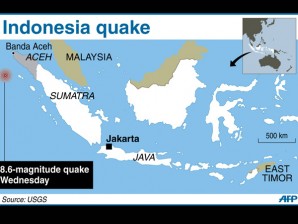Big Indonesia quakes trigger tsunami alert

Map of the Indian Ocean where a tsunami warning is in place Wednesday after a 8.6-magnitude earthquake off the coast of Indonesia
BANDA ACEH, Indonesia—A huge earthquake and strong aftershocks struck off Indonesia’s Sumatra island on Wednesday, triggering an Indian Ocean-wide tsunami alert that sent terrified people fleeing from the coast.
The 8.6-magnitude quake hit 431 kilometres (268 miles) off the city of Banda Aceh at 0838 GMT, and was followed by another undersea quake measured at 8.2, the US Geological Survey said.
Panicky residents poured into the streets of Banda Aceh, which was near the epicentre of a 9.1-magnitude quake in 2004 that unleashed an Indian Ocean tsunami that killed 220,000 people including 170,000 in Aceh province.
Wednesday’s quake was felt as far afield as Thailand, where skyscrapers in the capital Bangkok swayed. India, Indonesia, Kenya, Malaysia, Reunion Island, Sri Lanka, Thailand and Myanmar all issued alerts or evacuation orders which were later lifted.
Small tsunamis hit Indonesia and Thailand, with waves of up to 80 centimetres (31 inches) in Aceh, but there were no reports of damage or casualties.
US seismologists then cancelled the tsunami warning, saying the quakes had generated only small waves and were nowhere near the scale of the disasters that struck Asia in 2004 and Japan last year.
Earlier in Banda Aceh, there were chaotic scenes as people grabbed their families and raced through crowded streets, with motorbikes and cars jostling for space.
“There are people trying to evacuate, some are praying and children at a school were panicking as teachers tried to get them out,” an AFP correspondent in Banda Aceh said.
“There are traffic jams everywhere as people are trying to get away from the coast—many are on motorcycles,” he said, adding that telephone connections and electricity were patchy.
Television images showed hundreds gathering at a large mosque in Banda Aceh, many weeping and searching for family members. Women and girls draped head-to-toe in white were praying on mats laid out on the ground.
In Sri Lanka the disaster management centre asked residents on the coast to move inland to avoid being hit by any large waves. In the capital Colombo, nervous crowds gathered on the streets after the strong quake.
“There was a first jolt for five seconds, then a pause and then a really big one. It was really frightening, the whole room was shaking,” said 42-year-old tourist Maria Teresa Pizarro from the Philippines, which was exempted from the tsunami watch, according to the Pacific Tsunami Warning Center.
“You could hear the wood in the furniture cracking, the curtains were moving and the ceiling fan was rattling. I just picked up the children and ran downstairs,” she said from the city’s seafront Galle Face hotel.
Thailand issued an evacuation order for its Andaman coast, a popular tourist destination, and flights to the tourist island of Phuket were diverted to other airports as passengers and staff were evacuated to higher ground.
A small tsunami measuring just 10 centimetres (four inches) reached the coast before Thailand, like other countries, lifted its warning.
“At this point people can be relieved,” said Somsak Khaosuwan, the director of Thailand’s National Disaster Warning Centre.
Australian Bonnie Muddle, vacationing in the Thai resort island of Phuket, said people were evacuated from popular tourist areas including Krabi and Phang Nga bay.
“All the local villagers are up on the hill,” she told AFP. “Some boats have just left the dock and are anchoring out (which is) supposedly safer.”
India issued a red high-level tsunami warning for the Andaman and Nicobar Islands, located in the Indian Ocean, and lower alerts for several other eastern coastal states.
Tremors were felt in the Indian eastern city of Kolkata, where cracks appeared in some tall buildings. A large number of people rushed out of offices in the city’s central Park street area as windows and doors rattled.
In the Maldives, where luxury resorts cater to well-heeled holiday makers, hotels moved tourists away from beaches, with some even issuing guests with life jackets as a precaution.
The catastrophic tsunami of December 26, 2004, was generated by a 9.1-magnitude earthquake that struck in the ocean about 200 kilometres away from Wednesday’s initial quake.
An expert with the British Geological Survey said the tsunamis were small because the quakes’ movement was horizontal, not vertical, and caused no drop in the sea floor, which is what triggers tsunamis.
“Although an earthquake of this magnitude has the potential to cause a large tsunami… we haven’t seen any drop of the sea floor, which is what generates the wave,” seismologist Susanne Sargeant told AFP.
Last year, a 9.0-magnitude earthquake caused a tsunami and nuclear disaster in Japan, killing some 19,000 people.
The latest Indonesian quakes occurred in a notoriously seismic area, where the Indian tectonic plate descends into the Earth beneath the Eurasian plate. With a report from Frances Mangosing, INQUIRER.net
Originally posted at 06:14 pm | Wednesday, April 11, 2012














